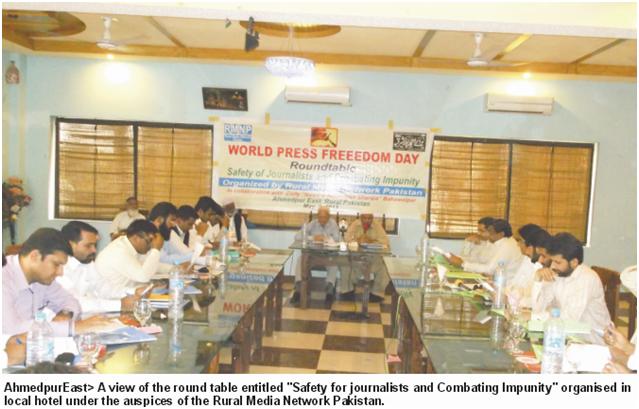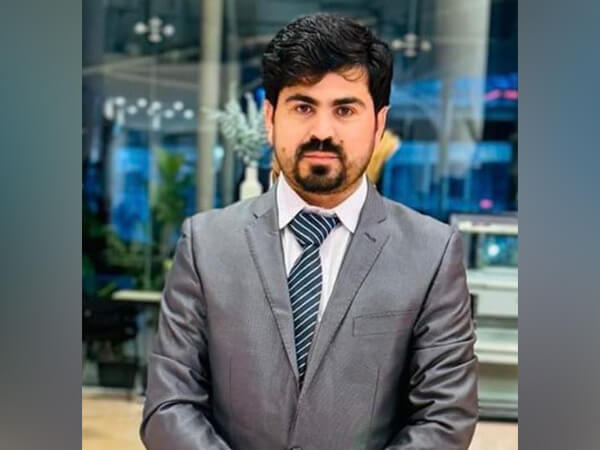WORLD PRESS FREEDOM DAY ROUNDTABLE “SAFETY OF JOURNALISTS and COMBATING IMPUNITY ORGANISED BY RURAL MEDIA NETWORK PAKISTAN IN COLLABORATION WITH RURAL DAILY NAWA-I-AHMEDPURSHARQIA DUA HOTEL, NATIONAL HIGHWAY, AHMEDPUREAST,RURAL PAKISTAN MAY 3, 2013
Recommendations
- The leadership of all political parties running for elections 2013 should publically declare, they respect the freedom of press and if come to power they will reopen the cases of journalist’s killings and criminals behind these killings would be taken to the task.
- Special workshops on safety and security for journalists working in rural areas should be arranged in small towns and international media organizations should focus on such areas which are more vulnerable.
- National and regional newspapers and TV channels should form unity. If a reporter or correspondent of one channel is attacked or killed, other channels avoid mentioning his or his organization’s name while broadcasting the news.
- Militant, extremist organizations and political parties should be contacted to reduce undue pressure.
- International journalists’ organizations should be requested to write letters to the media houses to provide security to the staffers working in sensitive areas.
- Coordination should be improved between news room and field teams as well as with correspondents and contributors on the issue of safety and security.
- A legal aid mechanism should be evolved and a safety fund should be created.
- All media houses must formulate standard operating procedures (SOPs) for journalists.
- An Eminent Group of Journalists should be set up to serve as mediation platform to forge consensus between media and the government authorities on the issue of safety.
- A special public prosecutor should be appointed to exclusively take up and pursue cases of attacks on media and media workers to promote a culture of justice and accountability.
- News channels should change their editorial policy and menace of “Breaking News” culture. Sometimes they ask questions which put their correspondent’s life in danger.
- Media houses should help their staffers to change work place if it is necessary for their security.
- The owners of newspapers and TV channels should provide complete insurance cover to their correspondents working in sensitive areas.
- A dependable mechanism must be evolved to identify the dangers and collect the information in rural areas to alert the journalists. RMNP has stressed again and again on this point.
- The newspapers and private TV channel owners must be taken onboard for security and safety of the journalists and for this purpose the All Pakistan Newspaper Society (APNS), Pakistan Broadcasters Association (PBA), Council of Pakistan Newspaper Editors (CPNE) and other media associations must be contacted.
SEMINAR REPORT
“We all know that reporting is a tough job in Pakistan. The country is still rated the most dangerous place to practice journalism”. Khalid Saeed, a Media Researcher and Trainer said while addressing a seminar on World Press Freedom day, under the auspices of press freedom organization, Rural Media Network Pakistan (RMNP) in collaboration with rural daily Nawai-Ahmedpur Sharqia in Dua hotel at National highway, Ahmedpur East, on May 3rd 2013.
He said, the common thing that ties the killings of all journalists from 2000 to 2012 (except Daniel Pearl of Wall Street Journal) is that their killers have never been found, prosecuted or punished. This is called impunity. The definition of impunity is “Exemption or freedom from punishment, harm or loss”.
In the same period, the number of journalists verifiably killed through specific targeting or those who lost their lives in deliberate terrorism-related violence (such as suicide attacks and bomb blasts) while out in the field reporting—in other words, killed in the line of duty—is at least 83.
Not the state, not the media organizations they worked for and not their families have been able to pursue justice, which allows for the killings of journalists—and non-fatal but dangerous and disturbing intimidation and harassment—to go unabated. He said.
He said unfortunately, on the issues of impunity against journalists, the right to exercise freedom of expression, indirect censorship offline and direct censorship online the country has also consistently ranked amongst the worst performers on these subjects on annual indices of organizations such as Committee to Protect Journalists (CPJ)Article IX, Freedom House, etc.
Khalid Saeed told the participants that looked at from any angle; the scale of impunity against journalists in Pakistan is staggering. According to data over 2000 journalists have experienced harassment, intimidation, kidnap, arrest, detention, assault and injury since January 2000. That’s an average of 166 cases every year or 6 cases a month.
He said it is also revealing that how these 83 journalists were killed. No less than 63 were sought out and shot dead in cold blood. Which means that in four-fifth of the killings, the work of these journalists massively upset the actors who killed them. Of those eliminated, 12 journalists abducted before being killed and their bodies dumped to be found to serve as warnings. At least 5 of these were brutally tortured in captivity before they were killed. Two were beheaded and one hanged. At least 10 journalists were killed in suicide attacks while they were out reporting on assignment and other 4 in bomb attacks.
He told the gathering, during 2000 and 2006, a total of 18 journalists were killed at an average of 2.5 every year or one about every 5 months. In the last five years—from 2007 to end 2012—the number of journalists killed shoot up to 65. That’s 13 every year, or staggeringly, one every 28 days.
Khalid Saeed said that without invoking the legal process, immunity cannot begin to be scaled down. Most journalists killed come from lower income backgrounds because of which after they are killed their families cannot pursue the vagaries of expensive and confusing justice system in Pakistan.
To solve this problem we have to launch a media legal aid program to formally start legal challenges against immunity by taking up cases of journalists in distress in courts through a cadre of lawyers trained in media defense, he said.
While doing this, we should keep in mind the rural areas of Pakistan. International donors’ give aids to such organization which are active in media hubs only. An organization based in Islamabad or Karachi will never go to help a journalist in Uch Sharif or Liaqatpur. The flow of aid must be re-directed towards local organizations, which are working in rural areas on safety issues for a long time, despite their meager resources, he stressed.
Mohammad Amin Abbasi President Bahawalpur Union of Journalists said statistics show, that contrary to belief, Sindh is the most dangerous territory in Pakistan to practice journalists with 23 killed in 12 years, including 17 in last 5 years.
The second worst place to be a journalist is Khyber Pakhunkhwa (KP) with a total of 18 killed in 12 years (14 in last 5 years) with a close third being Balochistan with 17 journalists killed since 2000. The Tribal Areas (FATA) and Punjab are tied for the fourth worst place to practice journalism with 11 killings each—most in both cases occurring in the last 5 years,
Majeed Gil Member FEC of Pakistan Federal Union of Journalists said Wali Khan Babar of Geo News was gunned down on January 13, 2011. A total of 23 people witnessed the murder, but only six had taken the risk of testifying before the Karachi Anti-Terrorist Court (ATC). But unfortunately , all the six were shot dead one by one in freighting systematically manner over a period of past 22 months.
He said this situation could make it impossible for the authorities to successfully conclude the trial and could dash any hope of justice in this case.
Senior journalist Junaid Nazir …said, if you look closely into the murder cases, you would find that almost in 60 per cent cases they crossed the “red line” knowingly or unknowingly. It is mainly because they were never trained how to handle certain situations in conflict areas.
He said significance of “red line” varies from region to region. For conflict areas, even reporting facts would tantamount to crossing this line for some stakeholders. It is too hard to report in these regions. If journalists take care of the so called “red line” (while reporting) they cannot do journalism.
RMNP trainer Nasir Hameed said that in sensitive areas of KP and Balochistan many journalists have left the profession because of security threats. Now stakeholders understand the importance of media and try to use it against their enemies.
“We need to fight the menace of breaking news” he insisted. “It forces journalists to take undue risks”.
He called upon the Pakistan Broadcasters Association (PBA) and the All Pakistan Newspapers Society (APNS) to sit together and formulate standard operating procedures (SOPs) for journalists.
President RMNP Ehsan Ahmed Sehar stated a special law to protect journalists is not a new concept. Multiple high-risk countries have experimented with different models of designating a special prosecutor for journalists killings.
He said there is a need for legislation for journalists’ safety without the usual complexities of current laws and the draft bill has to be prepared with all stakeholders on board.


